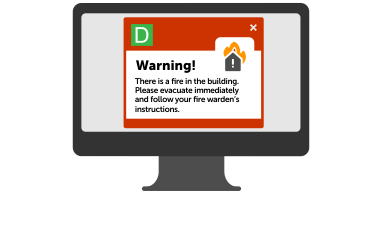Approved by Our Customers







Effective Crisis Communication for Safety and Integrity
A crisis can strike unexpectedly, so it's crucial to act swiftly to keep your employees informed. Crises can stem from natural or man-made disasters, lawsuits, scandals, or IT and product issues. Effective internal crisis communication ensures employee safety, maintains calm, mitigates reputational damage, and ensures employees get information directly from the company.

Maintaining Morale and Engagement During a Crisis
Quickly informing staff during a crisis is essential for maintaining employee morale and engagement. Effective internal crisis communication prevents rumors and ensures a unified response. When employees hear about a crisis from external sources, it can worsen the situation and lower engagement. Using crisis communication tools, like software or apps, keeps employees informed directly, supporting morale and engagement throughout the crisis.
For large enterprises with multi-site operations or global teams, explore our enterprise communication solution designed to coordinate rapid, secure crisis responses at scale.

Use DeskAlerts for Managing Crisis Communication
Communicate with Employees on Any Device: Desktops, Mobile Phones, and Digital Signage

IT Communications
- Send urgent messages with a 100% read rate, unlike email
- Inform staff in advance about maintenance
- Alert affected users about IT outages in one minute

Emergency Communications
- Use highly visible channels to send emergency communication
- Educate employees about emergency procedures in a highly engaging format
- Ensure critical information can be seen by everyone – even those not at their desks

Measure the Impact
- Use surveys and quizzes to test employees' knowledge of rules and policies and where to find them
- Analyze employee knowledge, message readership, survey answers and know the impact of your efforts

Inform About Changes
- Make every update known in a matter of hours
- Use desktop tickers to deliver the news fast
- Use digital signage to remind employees about new rules and drive behavioral change
Remote Team Communication Tools

Computer
Send engaging and highly visible messages bypassing emails, with a 100% read rate.

Mobile
Engage employees on their mobile devices even if they are not in front of the computer.

Features for Employee Engagement Communications

Targeting
Target and personalize your messages, using a number of parameters.

Scheduling
Prepare messages in advance and schedule them to be sent at a specific time and date.

Statistics
Get a deep understanding of the effectiveness of your communications and present the results.

Recurring Messages
Automate your messages and send identical messages in customizable intervals in an automated fashion.

Urgent Alerts
Your emergency alerts will appear on screen even if the employee’s computer is locked, on screensaver mode, or sleeping. Your message will be noticed despite uncontrollable circumstances.

Acknowledgment
Be sure that your employees saw your messages and acted on them.
Benefits of DeskAlerts as a Crisis Communication Software
- Informs remote, offsite, and traveling employees.
- Provides real-time updates as situations evolve.
- Enhances speed and efficiency of responses.
- Delivers accurate information directly to employees.
- Reduces anxiety and confusion by keeping employees connected.

What Our Customers Say About DeskAlerts

“We have been using Desk Alerts for 5 years now and find the product excellent at quickly communicating important information to our entire Trust. It is so easy to use and maintain, so it provides a cost-effective solution for “real-time” messaging. Originally used just by the IT team, the product is now in daily use by the Trust’s Communications team to ensure that urgent messages are communicated quickly and clearly to a large number of staff, thus helping to support the delivery of patient care to the highest standard.”
Lee Loades
Peterborough and Stamford Hospitals NHS Founation Trust

“DeskAlerts has helped in getting important info to the employees in a very quick manner. I would definitely recommend DeskAlerts to other contacts.”
Philip Weiss
MedAmerica

“We chose DeskAlerts as an efficient and fast way to send our employees, labs, groups and divisions messages. We like the features that let us send via SMS or email. We also like the surveys to collect information.”


